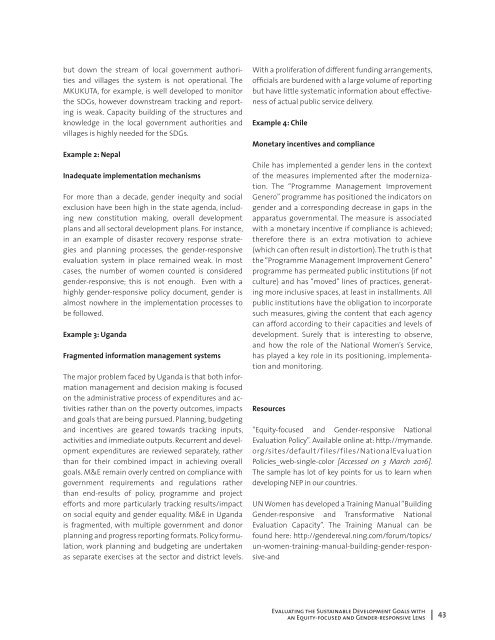NO ONE LEFT BEHIND
NY-Events-Report_WEB
NY-Events-Report_WEB
You also want an ePaper? Increase the reach of your titles
YUMPU automatically turns print PDFs into web optimized ePapers that Google loves.
ut down the stream of local government authorities<br />
and villages the system is not operational. The<br />
MKUKUTA, for example, is well developed to monitor<br />
the SDGs, however downstream tracking and reporting<br />
is weak. Capacity building of the structures and<br />
knowledge in the local government authorities and<br />
villages is highly needed for the SDGs.<br />
Example 2: Nepal<br />
Inadequate implementation mechanisms<br />
For more than a decade, gender inequity and social<br />
exclusion have been high in the state agenda, including<br />
new constitution making, overall development<br />
plans and all sectoral development plans. For instance,<br />
in an example of disaster recovery response strategies<br />
and planning processes, the gender-responsive<br />
evaluation system in place remained weak. In most<br />
cases, the number of women counted is considered<br />
gender-responsive; this is not enough. Even with a<br />
highly gender-responsive policy document, gender is<br />
almost nowhere in the implementation processes to<br />
be followed.<br />
Example 3: Uganda<br />
Fragmented information management systems<br />
The major problem faced by Uganda is that both information<br />
management and decision making is focused<br />
on the administrative process of expenditures and activities<br />
rather than on the poverty outcomes, impacts<br />
and goals that are being pursued. Planning, budgeting<br />
and incentives are geared towards tracking inputs,<br />
activities and immediate outputs. Recurrent and development<br />
expenditures are reviewed separately, rather<br />
than for their combined impact in achieving overall<br />
goals. M&E remain overly centred on compliance with<br />
government requirements and regulations rather<br />
than end-results of policy, programme and project<br />
efforts and more particularly tracking results/impact<br />
on social equity and gender equality. M&E in Uganda<br />
is fragmented, with multiple government and donor<br />
planning and progress reporting formats. Policy formulation,<br />
work planning and budgeting are undertaken<br />
as separate exercises at the sector and district levels.<br />
With a proliferation of different funding arrangements,<br />
officials are burdened with a large volume of reporting<br />
but have little systematic information about effectiveness<br />
of actual public service delivery.<br />
Example 4: Chile<br />
Monetary incentives and compliance<br />
Chile has implemented a gender lens in the context<br />
of the measures implemented after the modernization.<br />
The “Programme Management Improvement<br />
Genero” programme has positioned the indicators on<br />
gender and a corresponding decrease in gaps in the<br />
apparatus governmental. The measure is associated<br />
with a monetary incentive if compliance is achieved;<br />
therefore there is an extra motivation to achieve<br />
(which can often result in distortion). The truth is that<br />
the “Programme Management Improvement Genero”<br />
programme has permeated public institutions (if not<br />
culture) and has “moved” lines of practices, generating<br />
more inclusive spaces, at least in installments. All<br />
public institutions have the obligation to incorporate<br />
such measures, giving the content that each agency<br />
can afford according to their capacities and levels of<br />
development. Surely that is interesting to observe,<br />
and how the role of the National Women’s Service,<br />
has played a key role in its positioning, implementation<br />
and monitoring.<br />
Resources<br />
“Equity-focused and Gender-responsive National<br />
Evaluation Policy”. Available online at: http://mymande.<br />
org/sites/default/files/files/NationalEvaluation<br />
Policies_web-single-color [Accessed on 3 March 2016].<br />
The sample has lot of key points for us to learn when<br />
developing NEP in our countries.<br />
UN Women has developed a Training Manual “Building<br />
Gender-responsive and Transformative National<br />
Evaluation Capacity”. The Training Manual can be<br />
found here: http://gendereval.ning.com/forum/topics/<br />
un-women-training-manual-building-gender-responsive-and<br />
Evaluating the Sustainable Development Goals with<br />
an Equity-focused and Gender-responsive Lens 43


